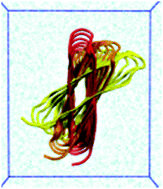Molecular dynamics-based strength estimates of beta solenoid proteins†
Abstract
The use of beta solenoid proteins as functionalizable, nanoscale, self-assembling molecular building blocks may have many applications, including templating the growth of wires or higher-dimensional structures. By understanding their mechanical strengths, we can efficiently design the proteins for specific functions. We present a study of the mechanical properties of seven beta solenoid proteins using GROMACS molecular dynamics software to produce force/torque-displacement data, implement umbrella sampling of bending/twisting trajectories, produce Potentials of Mean Force (PMFs), extract effective spring constants, and calculate rigidities for two bending and two twisting directions for each protein. We examine the differences between computing the strength values from force/torque-displacement data alone and PMF data, and show how higher precision estimates can be obtained from the former. In addition to the analysis of the methods, we report estimates for the bend/twist persistence lengths for each protein, which range from 0.5–3.4 μm. We note that beta solenoid proteins with internal disulfide bridges do not enjoy enhanced bending or twisting strength, and that the strongest correlate with bend/twist rigidity is the number of hydrogen bonds per turn. In addition, we compute estimates of the Young's modulus (Y) for each protein, which range from Y = 3.5 to 7.2 GPa.



 Please wait while we load your content...
Please wait while we load your content...